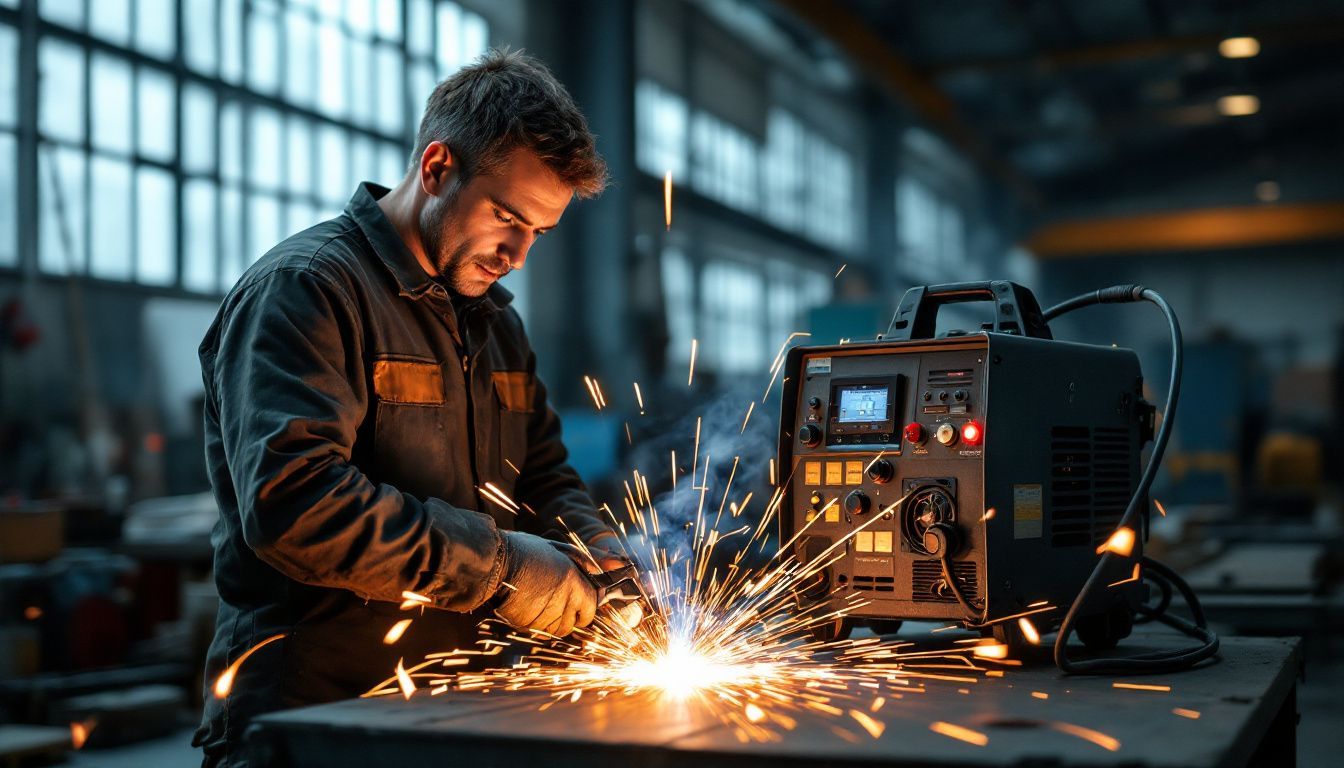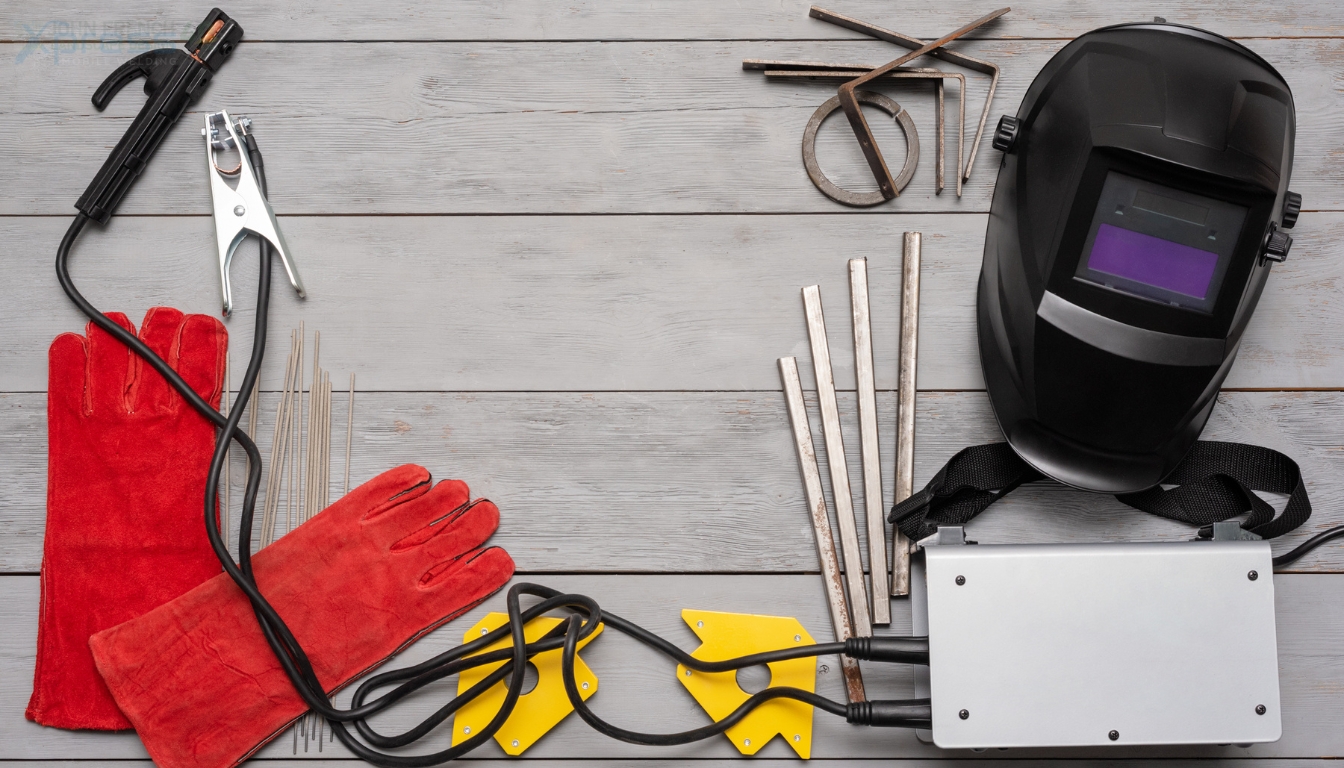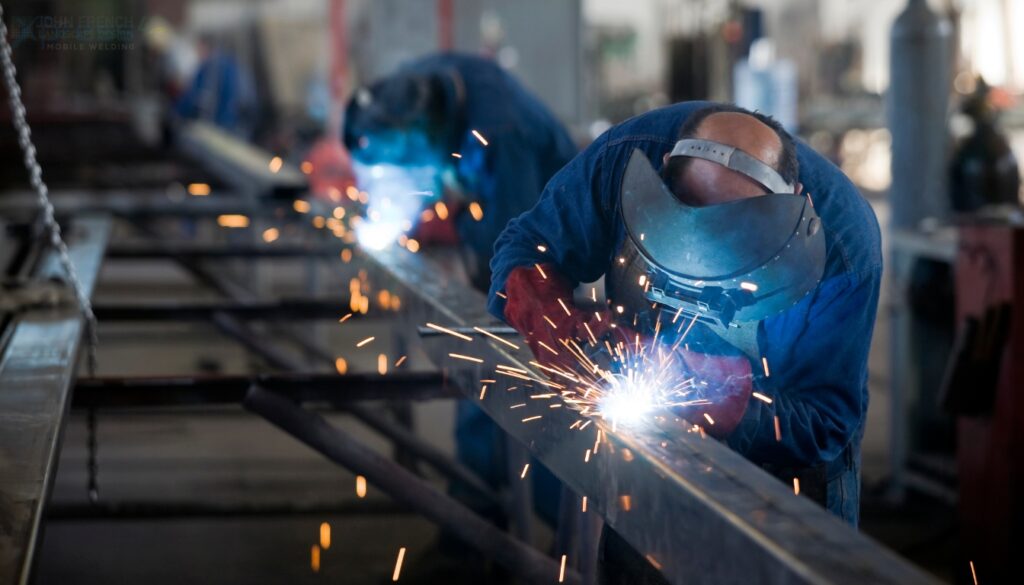Welding uses a significant amount of energy, increasing your operating costs. Energy-efficient welding machines can lower energy consumption effectively. This article offers energy efficient welding tips to help you reduce energy use.
Start minimizing your energy costs today.
Key Takeaways
- Use Inverter-Based Machines: Modern inverters use over 82% efficiency, saving energy compared to older models that use up to 255 kWh more each year.
- Choose the Right Welding Process: Methods like Pulsed MIG and Cold Metal Transfer reduce energy use by controlling current and lowering heat input.
- Maintain Equipment Regularly: Regular inspections and cleaning keep machines efficient, preventing energy loss from faulty parts.
- Implement Advanced Technologies: Technologies like Fronius CMT and WireSense can save up to 20% energy and improve weld quality.
- Train Staff and Optimize Settings: Educate workers on energy-saving techniques and adjust voltage and current to fit the material, reducing unnecessary power use.
Understanding Energy Consumption in Welding

To effectively reduce energy consumption, it’s essential to grasp how energy is used in the welding process. Welding involves high currents, often reaching up to 700 amps. This high energy use impacts electricity bills as well as the consumption of resources like shielding gas and welding wire.
Older MIG and MAG welding machines typically use constant coolant circulation, which wastes energy by generating excess heat. Inverter-based welding machines are more efficient. They create less extra heat, directing more energy into the actual welding work.
This shift helps save energy and lowers overall welding costs. Efficient energy use also means cleaner welds, leading to less need for rework and further reducing energy consumption.
Choosing the Right Welding Process
Choosing the right welding process is key to saving energy and ensuring quality welds. Select a method that fits your project needs and minimizes energy use.
- Assess Project Requirements
- Identify the type and thickness of metal.
- Gas Metal Arc Welding (GMAW) works well for thin metals.
- Shielded Metal Arc Welding (SMAW) is better for thicker materials.
- Evaluate Energy Consumption
- Pulsed MIG welding uses less energy than standard MIG.
- Cold Metal Transfer (CMT) controls current and lowers heat input.
- Consider Welding Speed
- Pulse Multi Control (PMC) welding is 15-20% faster.
- Faster welding reduces overall energy use.
- Choose Efficient Equipment
- Inverter-based power sources are more efficient than older models.
- They improve power factor and reduce energy waste.
- Ensure Weld Quality
- CMT stabilizes the arc for high-quality welds.
- Quality welds require less energy and fewer repairs.
- Maintain and Upgrade Equipment
- Regular maintenance keeps equipment running efficiently.
- Upgrading to modern welding power supplies can cut energy use.
- Implement Advanced Technologies
- Use pulse welding techniques for energy savings.
- A company saved 20% energy by adopting these methods.
- Select Sustainable Practices
- Choose welding methods that use renewable energy sources.
- Reduce energy waste by optimizing welding parameters.
By following these tips, you can choose the right welding process that saves energy and boosts productivity.
Optimizing Welding Parameters
Optimizing welding parameters can significantly reduce energy consumption and improve efficiency. By fine-tuning your settings, you achieve better weld quality and save on costs.
- Use Inverter-Based Welding Power Sources
- Inverters allow quick adjustments to voltage and current, enhancing weld bead quality.
- Modern inverter machines include power factor correction, achieving over Cos φ 0.95, which reduces energy waste.
- Select High-Efficiency Welders
- Choose welders like the Miller Dimension 652, which operates at 82.7% efficiency using 16.97 KW for MIG welding.
- Compare with competitors’ models that may only reach 63.46% efficiency and require 21.43 KW, leading to higher energy consumption.
- Adjust Voltage and Current Settings
- Tailor voltage and current based on the material thickness and type to minimize energy use.
- Proper settings ensure optimal energy when welding, reducing unnecessary power consumption.
- Monitor and Maintain Duty Cycle
- Keep track of the welder’s duty cycle to prevent overheating and excessive energy use.
- Maintaining the duty cycle helps extend equipment life and maintain overall efficiency.
- Regularly Calibrate Welding Power Supplies
- Ensure welding power supplies are accurately calibrated for consistent performance.
- Calibration helps maintain optimal energy input, enhancing energy conservation during operations.
- Upgrade to Newer Equipment
- Older inverter models may consume up to 255 kWh more annually compared to newer models, as shown by Fronius in 2024.
- Investing in the latest welding technology can lead to significant energy and cost savings.
By implementing these strategies, you can optimize your welding parameters for better energy efficiency and cost-effectiveness.
Implementing Advanced Technologies
After optimizing welding parameters, integrating advanced technologies can further enhance energy efficiency. Fronius CMT technology ensures a stable welding process with cleaner seams, reducing energy waste.
WireSense technology transforms welding robots into intelligent sensors, allowing precise control and minimizing excess power usage. TPS/i robotic welding offers greater precision and faster production times, decreasing overall energy consumption.
Automated welding systems handle repetitive tasks with high accuracy, lowering the need for manual adjustments and conserving energy. Digital innovations, such as smart welding power supplies and power electronics, optimize energy use across various welding outputs.
Embracing advanced technologies boosts efficiency and paves the way for a more sustainable welding future.
Maintaining and Upgrading Equipment
Regular upkeep of welding tools keeps them running smoothly and saves energy. Upgrading to advanced power supplies like inverters can lower power use and boost performance.
Welding Repair and Maintenance Tips
Maintaining welding equipment is essential for saving energy. Proper repairs keep machines running well and use less power.
- Invest in High-Quality Machines
Choose reliable welding power supplies. Good machines use less energy and need fewer repairs. - Conduct Regular Inspections
Check equipment often for signs of wear. Early repairs prevent energy loss from faulty parts. - Keep Equipment Clean
Remove dirt and debris after each use. Clean machines operate better and consume less energy. - Optimize Welding Parameters
Adjust settings like electric current and voltage. Proper settings reduce energy usage and improve performance. - Upgrade to Advanced Technologies
Use power inverters and modern transformers. These tools can lower energy consumption during welding. - Maintain Electrical Connections
Ensure all connections are tight and free from damage. Good connections reduce energy loss from resistance. - Implement Energy Audits
Evaluate energy usage regularly. Identify and fix areas where energy can be saved. - Train Staff on Maintenance
Educate workers on proper equipment care. Skilled maintenance leads to efficient energy use. - Replace Worn Parts Promptly
Swap out damaged components quickly. This prevents excessive energy consumption from inefficient parts. - Use Sustainable Practices
Recycle materials and use eco-friendly methods. Sustainable maintenance supports energy management goals.
Implementing Energy Management Practices
Implement energy management practices to cut energy use in welding operations. Switch to efficient welding power supplies like inverter machines. An automotive company saved 30% energy by making this change.
Use equipment like the Miller Dimension 652, which operates at 82.7% efficiency. It costs $8.27 per shift and saves $1,724 annually compared to competitors.
Train your welders in energy-saving techniques. Ongoing training helps maintain operational efficiency. Monitor and measure energy usage regularly. Tracking kilowatt-hour consumption reveals areas to improve.
Investing in energy management ensures welding equipment operates efficiently and reduces overall energy costs.

Utilizing Sustainable Materials and Practices
Transitioning from energy management practices, using sustainable materials boosts both efficiency and eco-friendliness in welding. Select durable and recyclable equipment to minimize waste and reduce energy use.
Multiprocess machines can handle different welding tasks, lowering the need for multiple devices and saving power. Optimizing wear parts application ensures tools last longer, cutting down on replacements and energy costs.
Adopting resource-conserving production methods supports economic sustainability. Fronius leads in this area with Wire Arc Additive Manufacturing (WAAM), which enhances welding technology and reduces energy consumption.
Recycling materials conserves natural resources and decreases electrical resistance and conductance in welding processes. These sustainable practices help manufacturers lower overall energy usage and achieve a better return on investment.
Future Trends and Innovations in Energy-Efficient Welding
Advancements in welding technology are making energy-efficient welding more attainable. Inverter machines are replacing older analog models, using power more effectively. Fronius CMT technology and Pulse Multi Control (PMC) systems boost productivity and reduce energy waste.
Automated welding systems ensure precise, repeatable tasks, minimizing errors and lowering energy consumption. Companies like Miller Electric are developing welders that cut energy costs and enhance performance.
Three-phase electric power and laser beam welding are becoming more common, offering higher efficiency and faster welding speeds. Innovations in software, such as program optimization and Software as a Service (SaaS), help manage and reduce energy use.
These trends show a clear move toward smarter, greener welding methods that benefit both businesses and the environment.
Conclusion
Energy-efficient welding saves power and cuts costs. Choose the best welding process for your needs. Modern inverter machines use less energy and work better. Keep your equipment well-maintained to ensure it runs efficiently.
Use these tips to make welding greener and more effective.
For more insights on how to keep your welding equipment in top shape, read our detailed guide on welding repair and maintenance tips.
FAQs
1. What is energy-efficient welding and why is it important?
Energy-efficient welding uses techniques that lower overall energy consumption. It helps reduce costs and lessens the impact on the natural environment. By selecting the most energy-efficient welding processes, businesses can save money and use less power from the power station.
2. How does TIG welding contribute to power efficiency?
TIG welding, or Gas Tungsten Arc Welding, uses precise control of the electric arc. This control reduces energy waste and increases output power. Using a quality welding power supply with stable direct current also helps make TIG welding more energy-efficient.
3. What role does a welding power supply play in reducing energy usage?
A welding power supply controls the input and output power for welding. Using a rectifier and diode bridge can improve power efficiency. Choosing the right power supply ensures that welding equipment operates smoothly, lowering energy consumption and costs.
4. How can selecting the most energy-efficient welding process impact costs?
Selecting energy-saving welding methods like laser welding or submerged arc welding can reduce the need for high voltage power. This choice lowers the overall energy costs for welding. Energy-efficient processes also decrease maintenance costs and extend the warranty of welding machines.
5. What maintenance practices ensure welding equipment operates efficiently?
Regular maintenance keeps welding equipment running well. Checking the welding power supply and rectifier helps maintain energy efficiency. Clean and inspect electric arcs and ventilation systems to ensure they work properly, which reduces energy consumption and prevents downtime.
6. How does automation contribute to energy development in welding?
Automation in welding uses computer hardware and software to control welding processes. It optimizes power usage by adjusting ampere and volt power settings automatically. Automated systems can analyze data to improve energy efficiency across a range of welding outputs, leading to greater energy savings.
Fast and Reliable Mobile Welding Services
Call us at (623) 263-0277 for top-notch mobile welding services! Visit us today for expert assistance and get your welding projects done on-site, quickly and efficiently.

